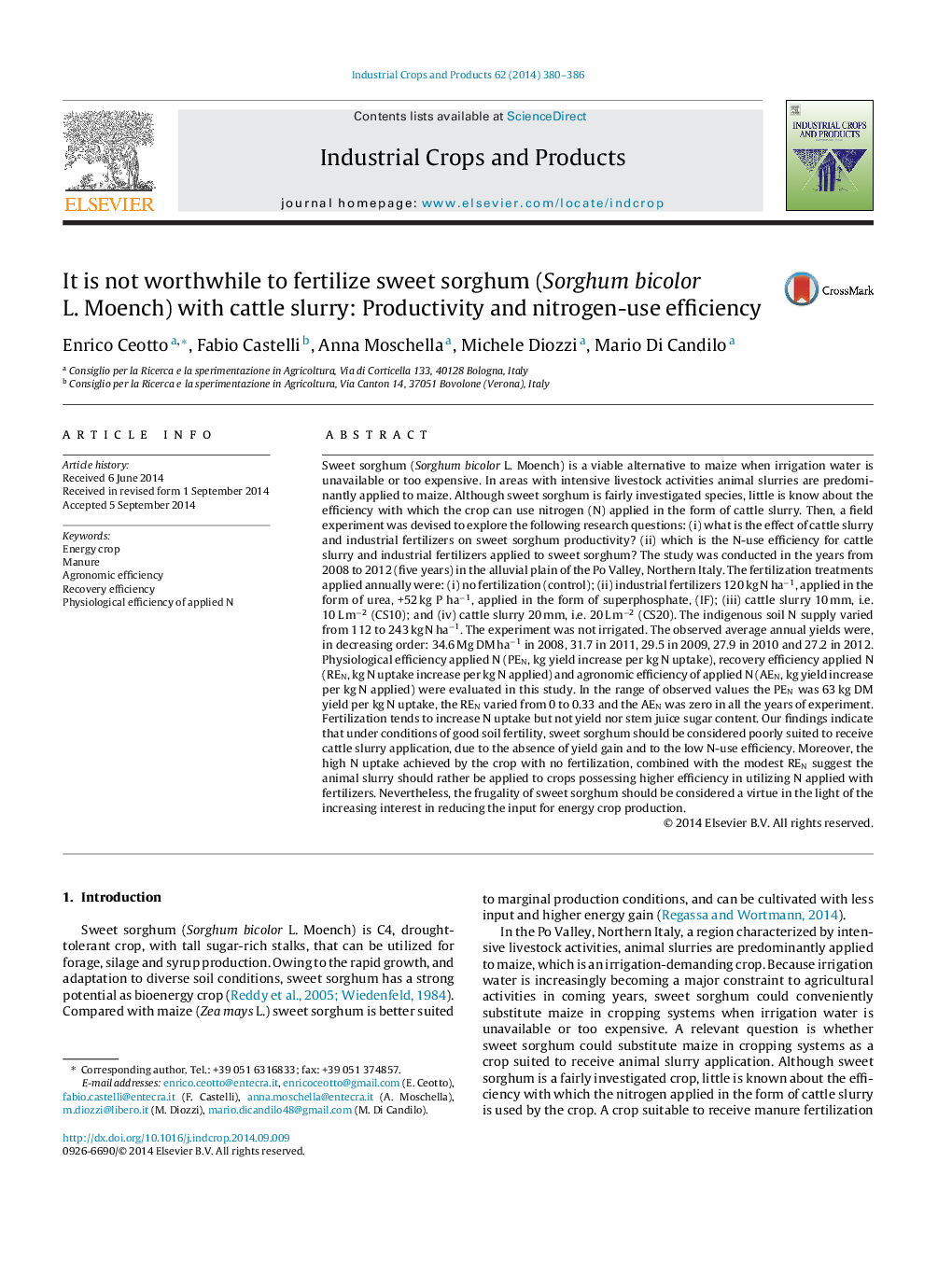| کد مقاله | کد نشریه | سال انتشار | مقاله انگلیسی | نسخه تمام متن |
|---|---|---|---|---|
| 6376550 | 1624847 | 2014 | 7 صفحه PDF | دانلود رایگان |
عنوان انگلیسی مقاله ISI
It is not worthwhile to fertilize sweet sorghum (Sorghum bicolor L. Moench) with cattle slurry: Productivity and nitrogen-use efficiency
دانلود مقاله + سفارش ترجمه
دانلود مقاله ISI انگلیسی
رایگان برای ایرانیان
کلمات کلیدی
موضوعات مرتبط
علوم زیستی و بیوفناوری
علوم کشاورزی و بیولوژیک
علوم زراعت و اصلاح نباتات
پیش نمایش صفحه اول مقاله

چکیده انگلیسی
Sweet sorghum (Sorghum bicolor L. Moench) is a viable alternative to maize when irrigation water is unavailable or too expensive. In areas with intensive livestock activities animal slurries are predominantly applied to maize. Although sweet sorghum is fairly investigated species, little is know about the efficiency with which the crop can use nitrogen (N) applied in the form of cattle slurry. Then, a field experiment was devised to explore the following research questions: (i) what is the effect of cattle slurry and industrial fertilizers on sweet sorghum productivity? (ii) which is the N-use efficiency for cattle slurry and industrial fertilizers applied to sweet sorghum? The study was conducted in the years from 2008 to 2012 (five years) in the alluvial plain of the Po Valley, Northern Italy. The fertilization treatments applied annually were: (i) no fertilization (control); (ii) industrial fertilizers 120 kg N haâ1, applied in the form of urea, +52 kg  P haâ1, applied in the form of superphosphate, (IF); (iii) cattle slurry 10 mm, i.e. 10 L mâ2 (CS10); and (iv) cattle slurry 20 mm, i.e. 20 L mâ2 (CS20). The indigenous soil N supply varied from 112 to 243 kg N haâ1. The experiment was not irrigated. The observed average annual yields were, in decreasing order: 34.6 Mg DM haâ1 in 2008, 31.7 in 2011, 29.5 in 2009, 27.9 in 2010 and 27.2 in 2012. Physiological efficiency applied N (PEN, kg yield increase per kg N uptake), recovery efficiency applied N (REN, kg N uptake increase per kg N applied) and agronomic efficiency of applied N (AEN, kg yield increase per kg N applied) were evaluated in this study. In the range of observed values the PEN was 63 kg DM yield per kg N uptake, the REN varied from 0 to 0.33 and the AEN was zero in all the years of experiment. Fertilization tends to increase N uptake but not yield nor stem juice sugar content. Our findings indicate that under conditions of good soil fertility, sweet sorghum should be considered poorly suited to receive cattle slurry application, due to the absence of yield gain and to the low N-use efficiency. Moreover, the high N uptake achieved by the crop with no fertilization, combined with the modest REN suggest the animal slurry should rather be applied to crops possessing higher efficiency in utilizing N applied with fertilizers. Nevertheless, the frugality of sweet sorghum should be considered a virtue in the light of the increasing interest in reducing the input for energy crop production.
ناشر
Database: Elsevier - ScienceDirect (ساینس دایرکت)
Journal: Industrial Crops and Products - Volume 62, December 2014, Pages 380-386
Journal: Industrial Crops and Products - Volume 62, December 2014, Pages 380-386
نویسندگان
Enrico Ceotto, Fabio Castelli, Anna Moschella, Michele Diozzi, Mario Di Candilo,